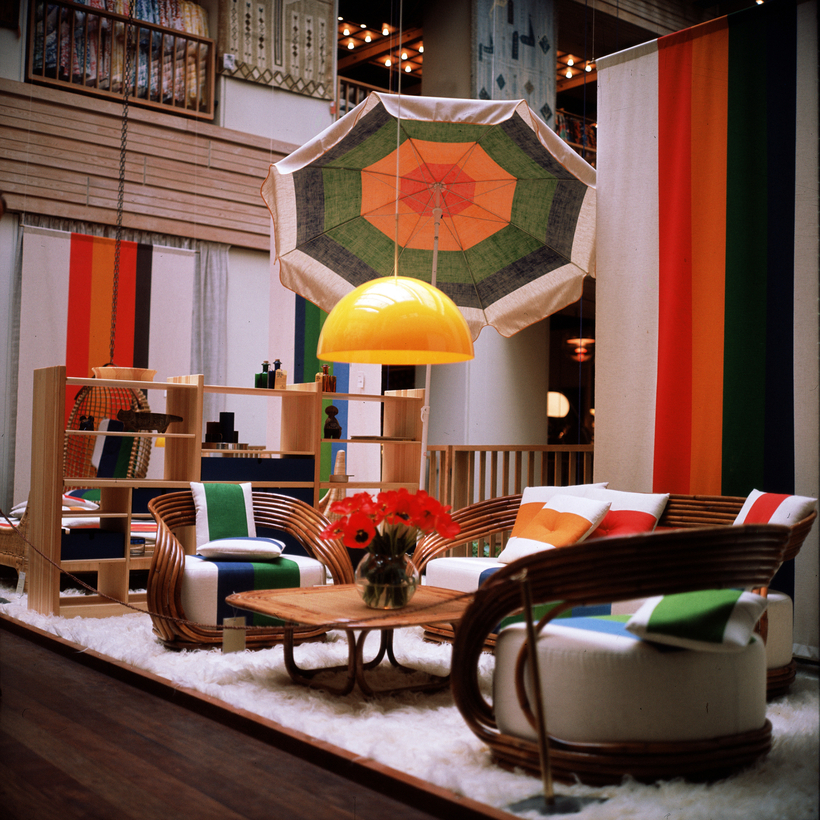On a September evening in 1960, Americans sat in darkened living rooms, transfixed by their flickering television screens. It was the first night of the Kennedy-Nixon presidential debates, and we all know the takeaway image: a haggard Richard Nixon stands at a lectern, glistening with sweat, while John Kennedy, seated with leg suavely crossed at the knee, is cool and calm in a Danish-modern chair. Scholars still argue whether that scene changed the outcome of the election. It is a fact, however, that the Danish chair, designed by Hans Wegner, became so well known that it was marketed in the U.S. as “The Chair.”
The debate and the chair form a touchstone that reminds us just how deeply Scandinavian design has penetrated American culture. On October 9, “Scandinavian Design and the United States, 1890–1980” opens at the Los Angeles County Museum of Art (LACMA), co-organized by Bobbye Tigerman, a curator of decorative arts and design at LACMA, and Monica Obniski, who was curator of 20th- and 21st-century design at the Milwaukee Art Museum when she worked on the show. (She’s now at the High Museum of Art, in Atlanta.) The exhibition uses 175 objects, from doilies to automobiles, to map out the relationship between American and Scandinavian design over the course of a century.

How America looks in the 2020s is usually traced back to the Bauhaus in 1920s Germany. The show at LACMA goes a different route. “Any designer working today,” says Tigerman, “whether they know it or not, has been shaped by Scandinavian design.” And the time line leads further back than you might imagine. Seven American world’s fairs have kept Nordic countries in the public eye. The Swedish Pavilion at the 1876 Centennial Exposition, in Philadelphia, was such a hit it was purchased for Central Park in New York City, where it still stands.
Decades before the arrival of Danish teak and Finnish crystal, in the 1950s, Scandinavian design in America was often a homegrown affair. Nordic immigrants brought their crafts with them, and as they assimilated, their work was popularized. A striking pair of candelabras, produced in the 1920s by Peter Berg and Yngve Olsson, displays the fusion of traditional form and modern sensibility that would become the calling card of Scandinavian-produced goods marketed in the U.S.

Following the Second World War, large-scale players, overseas and domestic, got involved and propelled the tidal wave of things Scandinavian. Nordic trade groups pushed to expand the market for their upscale goods. Museums and department stores across the country hosted a raft of exhibitions extolling Scandinavian products. American periodicals, such as House Beautiful, advocated for modern Scandinavian wares as aspirational design: in my own modest childhood suburb, it was the better-off families that furnished their homes with Danish modern. Even governments got involved. In an exercise of soft power, Norway, Sweden, and Denmark donated some of the most important interior spaces at the new United Nations headquarters, in New York City, including the Security Council Chamber.
Sometimes all the publicity was too successful. When there weren’t enough Scandinavian products to go around, American businesses were happy to jump in. Dansk marketed Danish style but was founded in a garage in Great Neck, New York, and its widely admired cookware was mass-produced in America.

Meanwhile, at a tiny Midwestern art school, a new and very different group of Scandinavian immigrants laid the foundations for an even broader and longer-lasting influence. The Finnish architect Eliel Saarinen moved to America in the 1920s, and shortly after designed the campus and the curriculum for the Cranbrook Academy of Art, just outside of Detroit. With an annual enrollment of only 150 students, the largely Scandinavian faculty, recruited by Saarinen, turned out some of the most important American designers and craftspeople of the 20th century, among them Charles Eames, Ray Eames, Florence Knoll, Harry Bertoia, Jack Lenor Larson, Ralph Rapson, Ed Rossbach, and Eliel’s son, Eero Saarinen.
And so began what Tigerman calls a “pedagogical chain of influence.” With each generation of Cranbrook artists and designers mentoring the next, the influence of Cranbrook’s founding faculty reached deep into art studios, design programs, and professional practices everywhere. Even as the wave of popularity for Scandinavian goods receded in the 1970s, that chain continued unbroken. —Lewis Jacobsen
“Scandinavian Design and the United States, 1890–1980” will be on view at LACMA from October 9 through February 5
Lewis Jacobsen keeps an eye on art and design from his aerie in Upper Manhattan while overseeing his New York architectural practice


 Discover
Discover